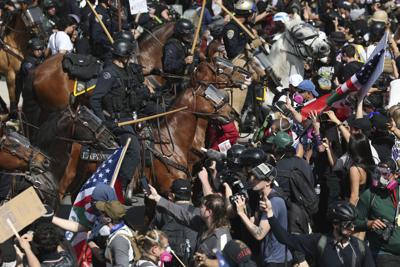Do you live here?
If you are not a member of one of the indigenous peoples, often referred to as First Nation people, you can probably track your ancestry to immigrants who came to America either hopefully in pursuit of happiness, safety or employment.
Or maybe you can track your ancestry to those who came here in despair after being captured and loaded onto a slave ship.
West Virginia even had a European office to recruit workers, especially coal miners.
Whether coming on a regular boat or on a slave ship, all came without citizenship papers or even a visa, landing in a location never before seen and generally with no invitation from existing occupants. In todayŌĆÖs terminology, all were ŌĆ£illegalŌĆØ immigrants. A more appropriate term might be ŌĆ£undocumentedŌĆØ immigrants.
The initial boundaries of the New World were expanded through methods of territorial acquisition by purchase, annexation, westward migration, diplomatic agreements and wars such as the Mexican-American War and subsequent cession of land.
All was fueled by the quest for land. All was driven by the concept of Manifest Destiny. No one considered that the concept of land ownership applied to the persons already living on the land, using and sharing the land and its resources, well before the first settlers arrived from Europe. The newly arriving immigrants were more interested in grabbing land than in sharing it.
In the economic history classes that I taught, I often asked students if their families owned property. Many raised their hands. I then ask them to track ownership. Most come back somewhat frustrated since their effort could only go back a very limited time, often less than 150 years. My next question then was on what basis did so-called legal ownership occur? In essence, that was the stumper since the obvious answer was that the land was taken by occupying or squatting on land often constituted as shared land hunting grounds by members of the indigenous people. In essence, the land was stolen or confiscated by force.
Those then in power concluded the land was free to take, use and distribute. Examples include George Washington's Lost Colony in Mason County and Abraham LincolnŌĆÖs act of giving 81,000 acres in Clay, Nicholas and Braxton counties to Simon Cameron in exchange for his political election support to Lincoln. That land was then transferred to his grandson, J.G. Bradley, who became a millionaire developing the Elk River Coal and Lumber Company in Widen. This kind of practice became typical.
Millionaires and billionaires initially obtained wealth by taking control of land and resources with force and with deals. There was nothing anywhere about deeds and illegal immigration was not a topic. If you got here or were dumped here, you simply fought to exist and climb any available ladder into the ŌĆ£promisedŌĆØ land. What you took became yours.
As Americans celebrate another Fourth of July, basic questions emerge. Independence from whom? Who had the legal right to grant it? Who legally owned America then? And who legally owns America today?
If ownership is net worth, the three richest Americans as of 2024 are Elon Musk at $374 billion, Jeff Bezos at $222 billion, and Mark Zuckerberg, also at $222 billion. If ownership is property, a weekly look at the ŌĆ£MansionsŌĆØ section in the Wall Street Journal will overwhelm you with the extravagant homes that rich people own. The effort to continue the tax breaks for these people will only widen the gap between them and those at the bottom. Obviously, continued independence and possession of wealth are their utmost priorities.
In essence, the Europeans who ŌĆ£discovered AmericaŌĆØ were immigrants who claimed the land was free for the taking. They then fought with each other and members of the First Nation to keep the stolen land and forced First Nation occupants into concentration camps called reservations. The War of Independence was a War of Conquest.
This phenomenon was not only in what is now the United States. It occurred in a similar way in Central and South America. It occurred in South Africa where most of the agricultural land is owned by white European immigrants. The battle for possession and control is basic to the question of who are legal or illegal immigrants.
This question was addressed by a photo taken by acclaimed photographer Earl Dotter. It shows a rustic sign on a coal camp house that reads ŌĆ£This world is not my home, I am just passing through.ŌĆØ This conveys a recognition that land ownership is temporary occupation, based on stolen property and territorial boundaries have no basis over time other than forced legal confiscation.
The bottom line, the question to consider, is whether anyone can legally claim ownership of land that they stole.











